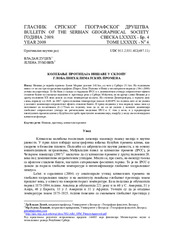Possible causes of contemporary Nisava River discharge variability
Kolebanje proticaja Nišave u sklopu globalnih klimatskih promena
| dc.creator | Ducić, Vladan | |
| dc.creator | Luković, Jelena | |
| dc.date.accessioned | 2021-09-24T15:17:29Z | |
| dc.date.available | 2021-09-24T15:17:29Z | |
| dc.date.issued | 2009 | |
| dc.identifier.issn | 0350-3593 | |
| dc.identifier.uri | https://gery.gef.bg.ac.rs/handle/123456789/305 | |
| dc.description.abstract | Nisava River is the largest tributary of the South Morava River of length 248 km, of which 151 km is in Serbia. Annually to all three hydrological profiles (Pirot, Bela Palanka and Nis) in the reporting period (1961-2000) has been observed decrease in discharge. That would be in accordance with the IPCC's claims about the domination of the influence of anthropogenic greenhouse gases on the reduction of rainfall and discharge in Serbia. However, the area of the Nisava basin in the second half of the XX century has shown decrease in air temperature. The station Dimitrovgrad, in the upper part of the basin, from 1949 to 2007 showed trend of annual temperature of -0.0049ºC per year, which does not fit to the concept of dominance of anthropogenic greenhouse gases. And the trend of rainfall in this period, changes sign from negative to positive (0.1175mm per year), so that it does not fit the concept of domination of the global anthropogenic impact on regional models of IPCC. Regarding to this and projections of possible climate change in the future all potential climatic factors should be taking into account. | en |
| dc.description.abstract | Nišava je najveća pritoka Južne Morave dužine 248 km, od čega u Srbiji 151 km. Na godišnjem nivou se na sva tri hidrološka profila (Pirot, Bela Palanka i Niš) u posmatranom periodu (1961-2000) uočava pad proticaja. To bi bilo u skladu sa tvrdnjama IPCC-a o dominantnom uticaju antropogenog efekta staklene bašte na smanjenje padavina i proticaja reka u Srbiji. Međutim, na području sliva Nišave je u drugoj polovini HH veka došlo do pada temperature vazduha. Na stanici Dimitrovgrad, u gornjem delu sliva, periodu od 1949. do 2007. trend godišnje temperature iznosi -0,0049ºC po godini, što se ne uklapa u koncept dominacije antropogenog efekta staklene bašte. I trend padavina u tom periodu menja znak od negativnog ka pozitivnom (0.1175mm po godini), tako da se ni on ne uklapa u koncept dominacije globalnog antropogenog uticaja po regionalnim modelima IPCC-a. S tim u vezi, i u projekcijama eventualnih promena klime u budućnosti treba pristupiti kompleksnije, imajući u vidu sve potencijalne klimatske faktore. | sr |
| dc.publisher | Beograd : Srpsko geografsko društvo | |
| dc.relation | info:eu-repo/grantAgreement/MESTD/MPN2006-2010/146005/RS// | |
| dc.rights | openAccess | |
| dc.rights.uri | https://creativecommons.org/licenses/by-nc-nd/4.0/ | |
| dc.source | Glasnik Srpskog geografskog društva | |
| dc.subject | Nisava River | en |
| dc.subject | discharge | en |
| dc.subject | climate change | en |
| dc.subject | Nišava | sr |
| dc.subject | proticaj | sr |
| dc.subject | klimatske promene | sr |
| dc.title | Possible causes of contemporary Nisava River discharge variability | en |
| dc.title | Kolebanje proticaja Nišave u sklopu globalnih klimatskih promena | sr |
| dc.type | article | |
| dc.rights.license | BY-NC-ND | |
| dcterms.abstract | Дуцић, Владан; Луковић, Јелена; Колебање протицаја Нишаве у склопу глобалних климатских промена; Колебање протицаја Нишаве у склопу глобалних климатских промена; | |
| dc.citation.volume | 89 | |
| dc.citation.issue | 4 | |
| dc.citation.spage | 255 | |
| dc.citation.epage | 276 | |
| dc.citation.other | 89(4): 255-276 | |
| dc.citation.rank | M24 | |
| dc.identifier.fulltext | https://gery.gef.bg.ac.rs/bitstream/id/271/303.pdf | |
| dc.identifier.rcub | https://hdl.handle.net/21.15107/rcub_gery_305 | |
| dc.type.version | publishedVersion |


